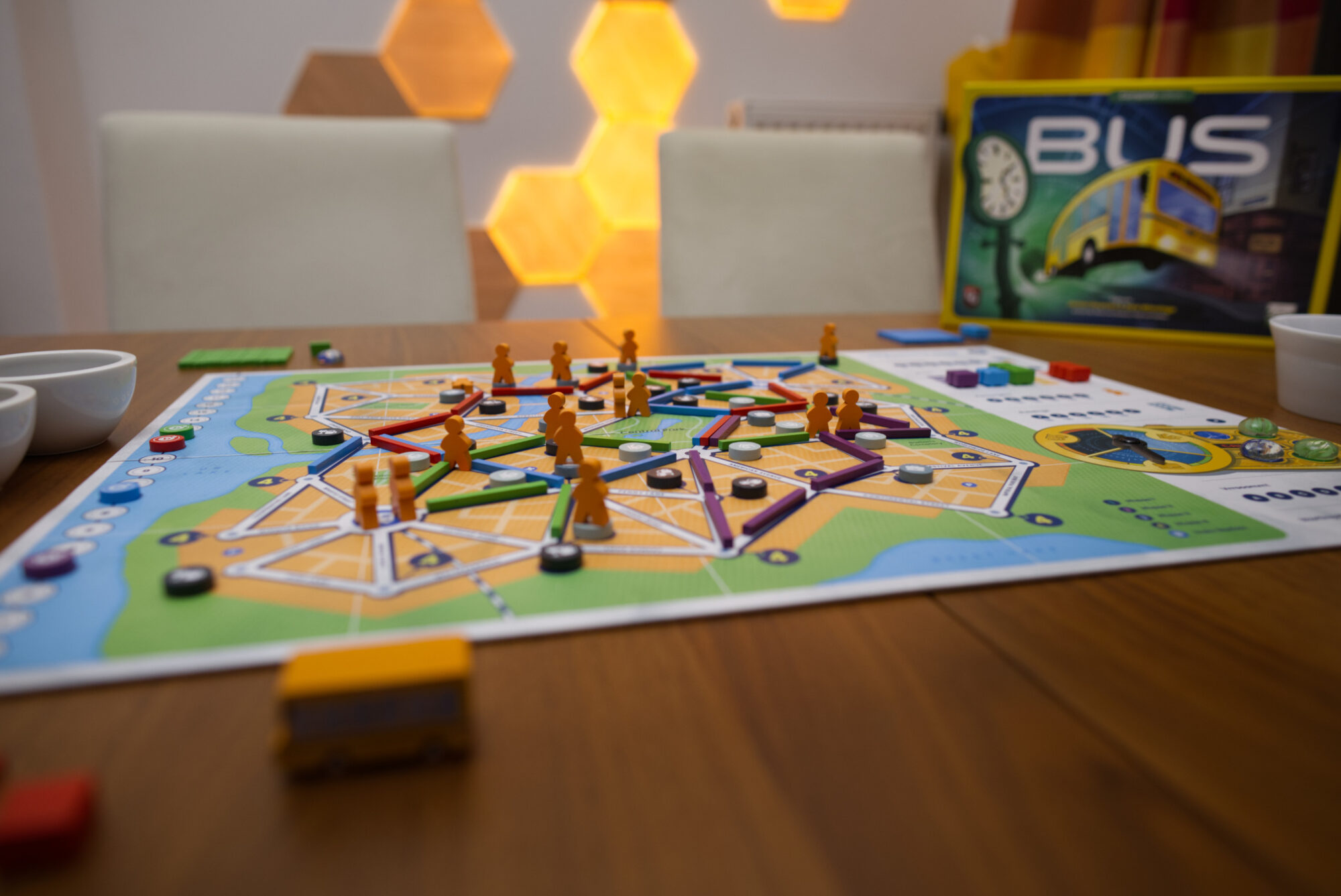Over the past year, I have been on sort of a deep dive, trying to explore as many games from Dutch design duo / boutique publisher Splotter Spellen as I can. If you are not aware of their oeuvre, their games are highly diverse in topics and mechanisms – from managing org-charts of a fast food chain in Food Chain Magnate to the effects of pollution in medieval Italy in Antiquity – but they definitely have a common DNA they all share: Every Splotter game does something uniquely different, both compared to other Splotter games as well as any other game out there. They have a tight, interlocking system of simple rules that creates rich depth and complexity. And player interaction is always at the heart of it all, making them the perfect counter point to the modern heavy, 20+ pages, multiplayer-solitaire Euro.
On the flip side, Splotter productions are – let’s call it – unusual, starting with the fact that re-prints even of their most successful titles can sometimes be a decade apart. Instead of minis and dual-layer boards, they often feature tons of tiny cardboard chits or other fiddly components. Calling their art style “boldly different” would put it mildly as they range from child-like in Roads & Boats to plain in Food Chain Magnate, or artistic approaches that can hurt usability like in Indonesia. And their asking price is usually in the 80-100€ range, putting them in competition with over-produced crowd funding projects.
In that sense, Bus might be the quintessential Splotter in that even its re-styled Capstone Games edition LOOKS more like a 30€ game for children but FEELS like one of the most astonishing pieces of game design you might ever play! So for a moment, ignore those tabs of Kickstarter projects you likely have open right now, look past the visuals and hefty price tag of Bus, and let me tell you why you might want to pick up “that strange yellow box with the bus on it” …
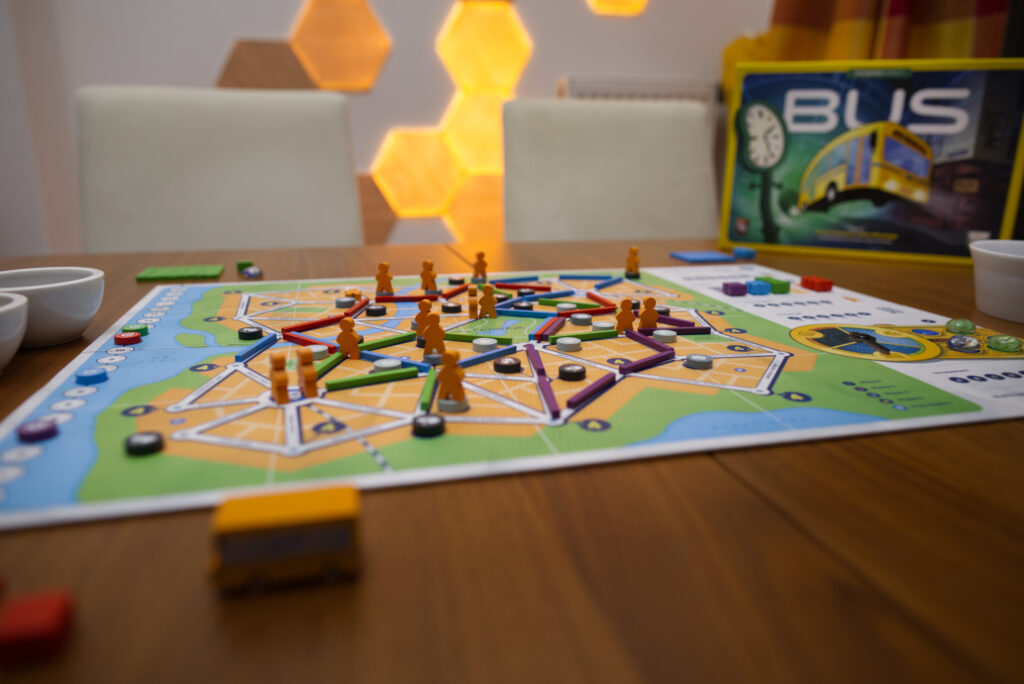
Setup
Setting up Bus is pretty much as simple as it gets: unfold the main board, give each player a small baggy of wooden components of which they place their scoring markers and a single bus on the respective tracks, put a passenger on each of the four central roundabouts, place the 5 marble like stones on their respect spots, and point the hand on the clock to the “home” destination. That’s it! You’re good to go and dive into the initial seeding phase.
In Bus, players build bus routes (long wooden sticks) through a city to hopefully transport passengers (orange meeples) to their current destination as indicated on the clock that’s integrated into the board. They either want to head to work, to the pub, or home, all of which are represented by small screen-printed wooden discs. As part of setup, each player places two buildings of their choice on potential building locations in the city, grouped into phases 1 to 4. Initially only spots marked with a 1 can be used until all are filled, which unlocks those marked with a 2, and so on. Note here the first unusual aspect: Bus features a fixed city plan of possible routes and building locations, but it is up to the players to place the initial buildings. There is no random placement of variable board components as featured in so many modern games to provide replayability, no multiple maps, nothing. The board is a blank canvas that the players fill, pushing the game in certain directions before it even starts. Some types of buildings might be more frequent than others or not appear at all. They might be bunched in the center or more spread out. Whatever will happen, it’s the players’ own doing.
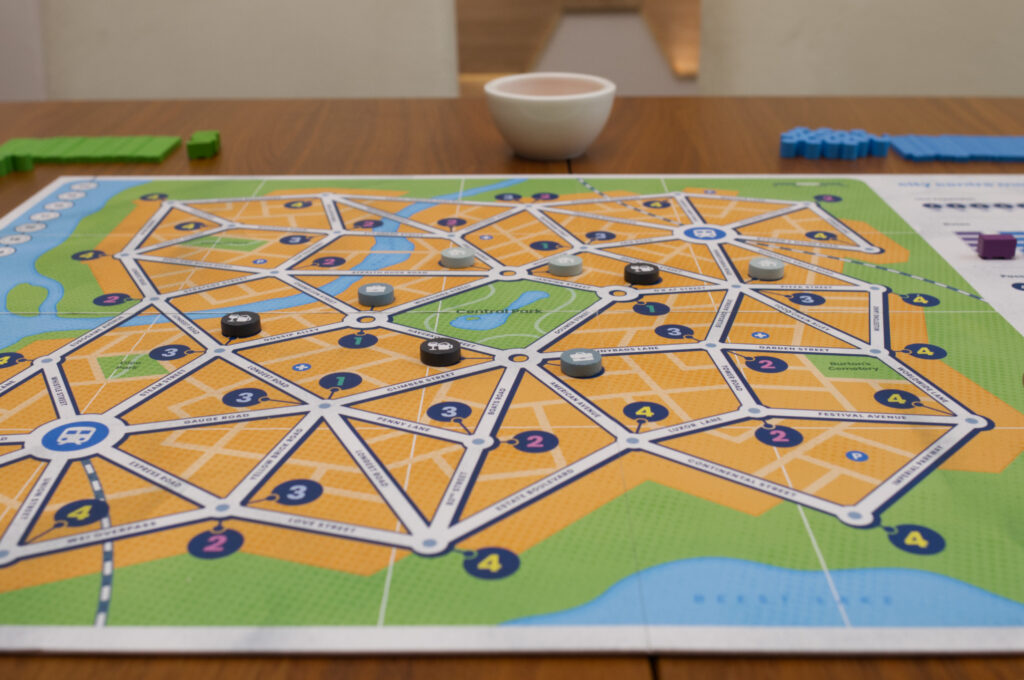
After placing the initial buildings, each player places the two initial segments of their bus route. One of the core rules of Bus is that each player only has one consecutive route, no junctions, always with a clear start and end. The other is that – with a few exceptions – only a single player can claim each street, so players will inevitably block each other and cut off their potential for expansion. But there are no rules where to place those initial segments. Place them closer to one of the two train stations where new passenger might show up or in the center for strategic reasons? Close to other players to be in competition or rather carve out your own part of the city? Whatever it is, distances in Bus are relatively short and the game inevitably will feel like a knife fight in a phone booth.
Choosing Your Actions
Each round of Bus is split into two phases. First, players take turns placing their action markers onto one of seven possible actions, one-by-one until all players have passed. Then they execute those actions as printed on the right side of the board, from top to bottom and left to right.
“Line Expansion” gives players access to more locations in the city, “Buses” increases the capacity of how many passengers can be moved, “Passengers” makes new passengers appear in one of the train stations, “Buildings” allows constructing new destinations, “Vrooom” allows actually transporting passengers to their destination, and “Starting Player” influences turn order for the next round. If you have no clue about Bus but played any board games at all, you at this point likely have a pretty good idea of how the game might play out. You’ll pick up passengers, make sure your route grows nicely, and there will be the buildings along your route to transport them to. So far, so boring, right? You’ll probably even prefer to play Ticket to Ride because there at least you have to collect sets of cards and have some hidden goals. So what’s so interesting about Bus?
Let’s rewind and dissect what I wrote. Players place their action markers, which sounds simple and straight forward. You’ve heard of worker placement, so what’s the big deal here? Ignoring that Bus is considered by many to be the first ever worker placement game (many years before even Agricola), these workers are actually one-time use! Each player starts with the same limited number of action markers and can play as many or few per round as they want, given they fulfil the minimum of at least two. The problem is players don’t know if the game will end up being a rather quick one with only 5-6 rounds or a longer one with 7-8 rounds. One game it might be great to pace yourself and end up being the only player with any serious amount of actions left to spent while in the next the game might be over before you get a chance to use them.
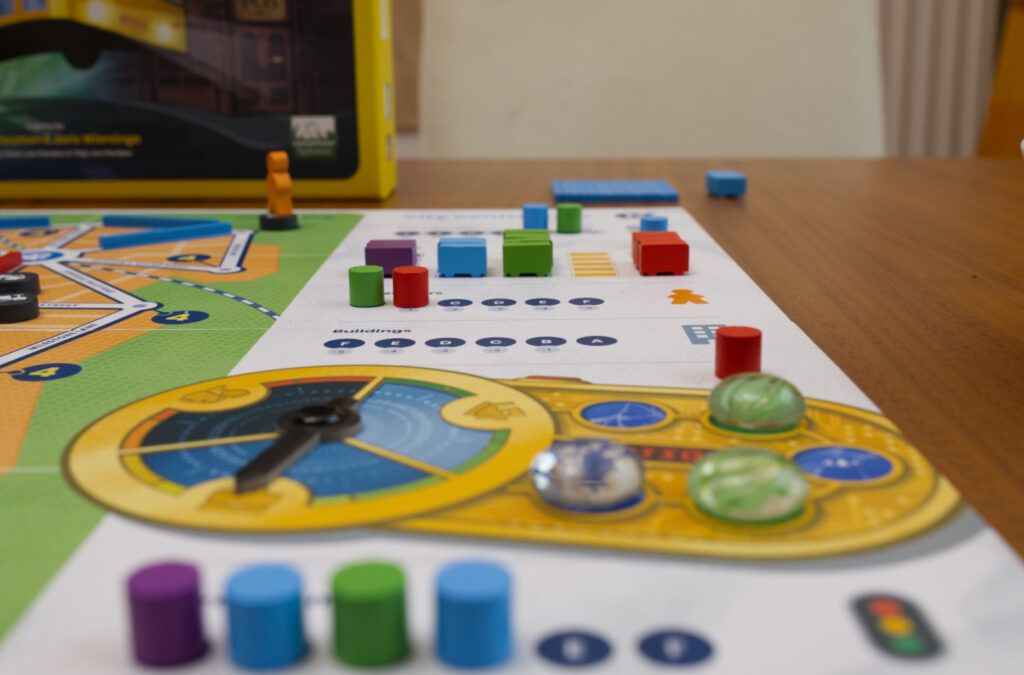
Then there is the simple fact that order of placement doesn’t necessarily align with the order of execution. All action spots are marked with letters from A through F, indicating in which order they have to be filled. But the order of execution is always from left to right. For example, the first player to choose Line Expansion will be the last to be able to do so because the “A” spot is at the very right. And since spots per action are limited, there is a choice to be made of whether to go for an action early to ensure you’ll be able to do it at all or wait for others to go their first and execute the action before them … running the risk that someone else might take the last available spot before you can do so.
Add to that the fact that the power of an action increases over time. For Line Expansion, Buildings, and Passengers, the number of pieces placed depends on the maximum number of buses any player has, called the “bus maximum”. E.g. if one player has 3 buses and that is the maximum, all players can do the aforementioned actions three times for a single action marker. This creates a nice natural ramp up where players can do bigger and bigger moves as the game progresses while having fewer lucrative options as choice places might have been claimed earlier in the game.
Add to that the fact that not all spaces for an action are equal, giving penalties to players that chose an action later in the round. Again looking at Line Expansion, the first player to choose it can extend last but do so a number of times equal to the current bus maximum. The next player goes second to last in execution but can do it one time less, the next player two times less, and so on, increasing the dilemma whether to go their first or wait. Being able to place a single route segment first might be more valuable than being able to place multiple after all the critical streets have already been claimed. This mechanism also opens up the opportunity space as the game progress. In the first round, the bus maximum is inevitably 1 during Line Expansion, and so only a single player can place a single segment in the first round. As the Bus Maximum increases, more and more players can do a line expansions in the same round.
There are already a lot of juicy decisions to be made just by the way the core worker placement mechanism is implemented, independent of what the actions themselves actually do. And those dilemma are created by simply limiting the number of a component and adding letters and some numbers to the action spaces. Minimal effort, maximum effect.
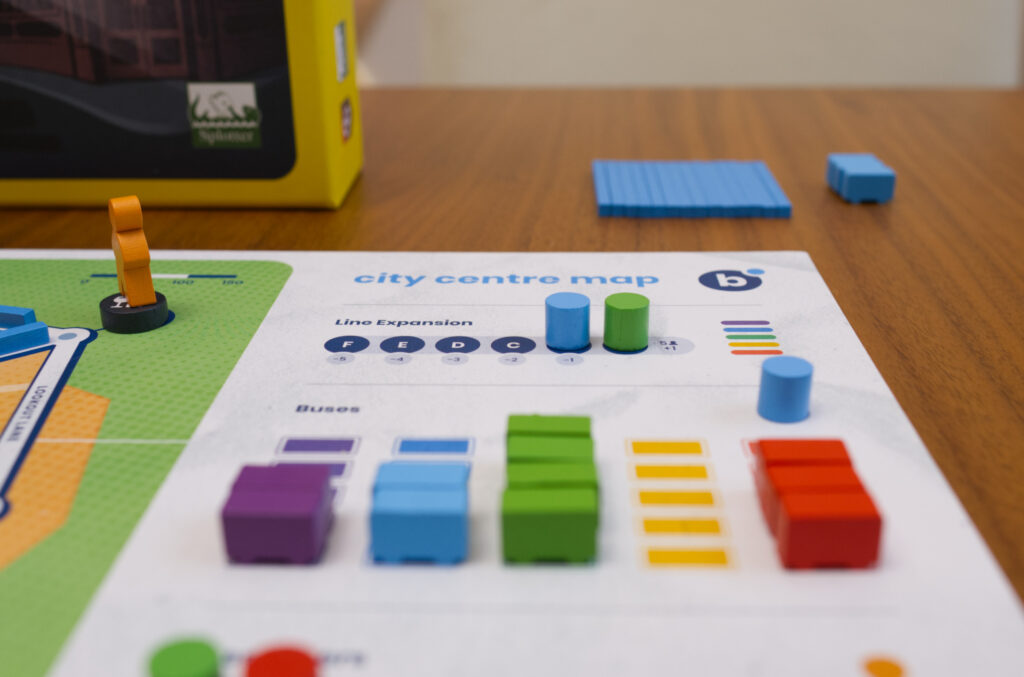
Building a Route
The same trait can be found in all the game’s actions. Route building could be pretty boring if it weren’t for the fact one is only allowed to extend it at the ends. This makes blocking other players – either intentional or unintentional – simple and timing a potential line expansion right crucial.
Then there is the placement of the buildings. Having building spots grouped in phases sometimes forces players to build in locations they don’t want to or even involuntarily unlock the next group of locations for the next player. It can be used constructive to place more of this turn’s destination on your route or place another type in preparation for next turns. It can also be used offensively by placing currently irrelevant building types on opponents’ routes and take away their building spaces. The most annoying way to use buildings though is to place the type that passengers currently want to go to next to a passenger on an opponents route, making the passenger stay there and unable to be scored at all that round!
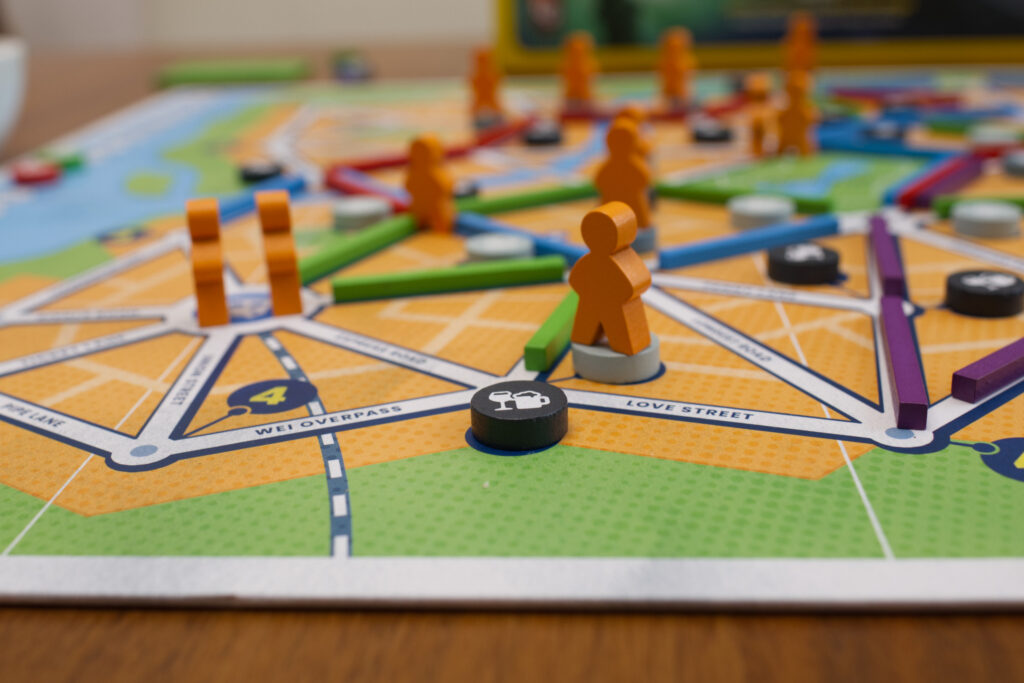
I Like To Move It, Move It
Another clever detail is that each building can only hold a single passenger, making the position of one’s action marker in the Vroom action order highly relevant. Earlier players might not only be able to steal away passengers from competing bus routes but also fill up the buildings they share with other routes, hurting two opponents with one move. The distance of how far a passenger must travel along a route to get to their destination however is irrelevant, allowing for some amazing steals. You might end up expanding your line brilliantly, placing the right buildings along it and even attract new passengers to the connected train station, but all of them might be used up by your opponents before it’s your turn to move.
That, combined with the fact that some actions only have a single action spot, of course make the Starting Player action highly valuable. Yet it costs a whole action marker that could have been used for something else and it costs time because to claim the starting player means of course to leave some other high-value action to the competition. Depending on player order, it can sometimes even make sense to do the absolute minimum in one round, grab the starting player, and rather set oneself up for a big move in the next round than spending any effort on the current one.

And If All Else Fails, There is Time …
I initially wrote “seven actions” but only described six so far. One common trait of all Splotter games is that they have an unusual quirk, something that wouldn’t quite make sense in the real world, a curve ball that one doesn’t expect. In Indonesia, it’s the fact that you have to sell everything you produce, even if the shipping costs will ruin you. In Antiquity, it’s that basically every location can only be harvested once, forcing players to clash into each other in the search for new lands. In Bus, there is time.
Each round, time progresses, turning the hand on the clock to indicate a different destination all passengers want to go to. Once they are done working, they all want to go to the pub, giving players new opportunity to score points. If things don’t go your way though – let’s say you can spot you’ll be too late in Vroom order and other players will basically get all the points – you can take the clock action and – I kid you not – stop time! Instead of heading to the pub, the universe collectively decides everyone should stay at work a bit more which of course means most of destinations will already be pre-filled from the previous round. But if you anticipate someone might stop time this round, you might be able to take the Buildings action and simply place some new, empty offices on your route to deliver passengers to.
The ability to stop time and basically screw over all planning alone is bonkers. But the best thing about it is you don’t have to use it! If a player places a marker on the Clock action, that means they CAN stop time, but they don’t HAVE to stop time. They can watch how the round plays out and just before the Vroom action decide what’s more opportune for them: stop time or let is pass normally? Even going to that action is already a giant threat for the other players, forcing them to remain more flexible and less optimal. There are two downsides though: again, placing a marker there costs a) one of those limited markers and b) time. And if a player actually ends up stopping time, they have to pick up one of those marble-like time stones which is worth minus one point, which can be quite a lot.
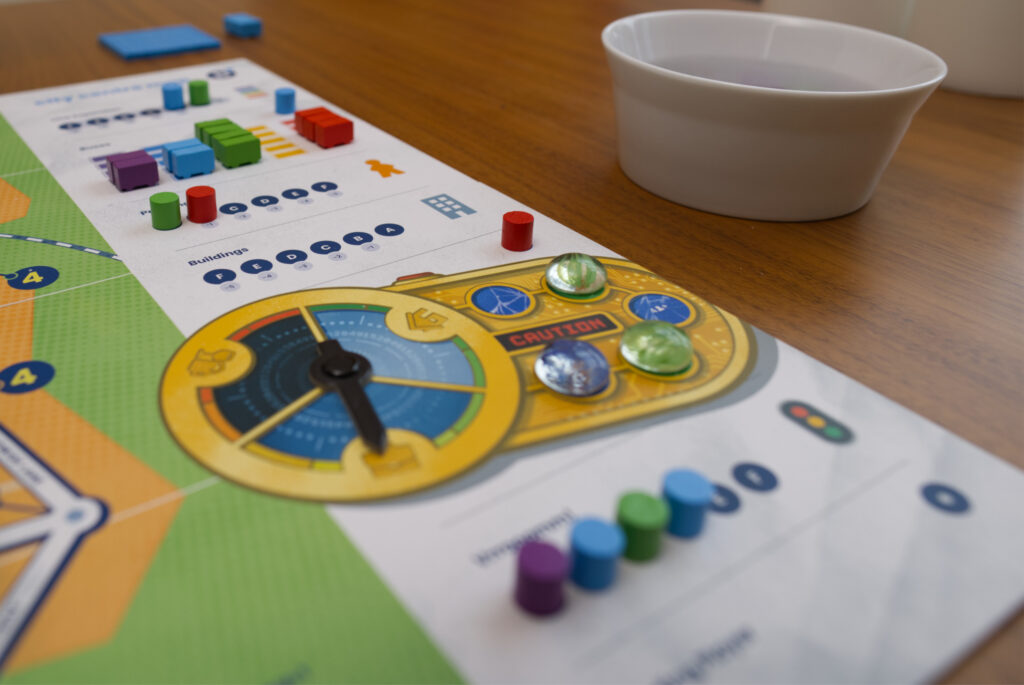
Game End
The game can end multiple ways but usually does so when only one player is left with any action markers. Note it’s not when the first player has no more markers as in many other games. Here, it’s all players save one have run out, making it both risky to sit on markers for too long and highly lucrative if one perhaps plays a whole round or two more than some other players. The other major way to end the game is if the last time stone is picked up. In that case, the game ends immediately and that rounds Vroom action won’t even be done … another fun way to screw over an opponent that was gearing up for a big payday.
So how does one win? Every passenger transported to their destination throughout the course of the game is worth one VP. One single, measly VP. Each time stone on the other hand is worth -1VP. I’ve seen games with wining scores as low as 7 VP and as high as 14 VP, depending on how much players block each other. As a result, every single passenger stolen or every destination filled by someone else really hurts. The only game that comes to my mind where a single VP is worth this much is Dune Imperium, and that’s one of the tightest fights for points in recent board gaming history.
For a final twist, the tie breaker isn’t as expected to have the least amount of time stones but the most. In a game with these low amounts of VPs, a tie is quite common, thus encouraging players to at least once mess with time.
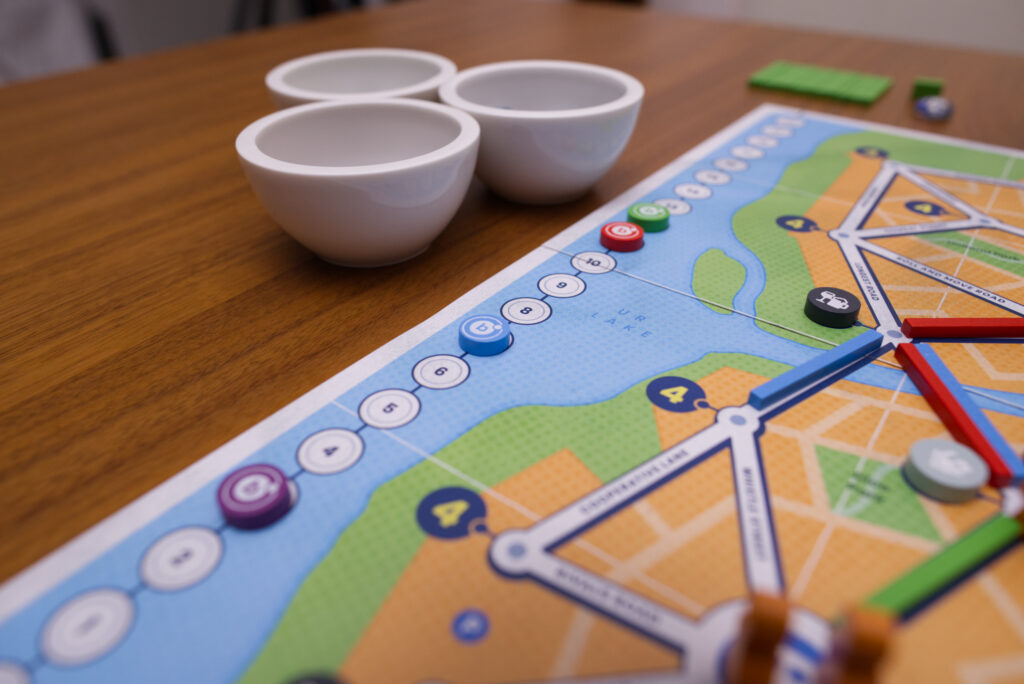
Player Count & Solo
Since Bus is so highly dependent on player interaction, the minimum player count is unfortunately three (with a maximum of five), which can make it tricky to get Bus to the table. It’s the typical opportunity cost: why play Bus if you could play some current hotness or your favourite game instead? I don’t know about your playgroups, but I currently have much more opportunity to play with two players or solo than I have with three or four. I also enjoy playing solo to get many reps in for a game quickly and explore it more deeply.
Bus is 25 years old by now, way before solo modes and automa became a thing. So I once again crafted my own solo mode which you can find here. It requires just two D6 and can be used both for solo and to add dummy players for lower player counts. It’s still in development but already highly enjoyable to play and at least one of the automa usually scores within a +1/-1 VP margin of my score, making for some tight end games. I’m really happy how this one is turning out so far!
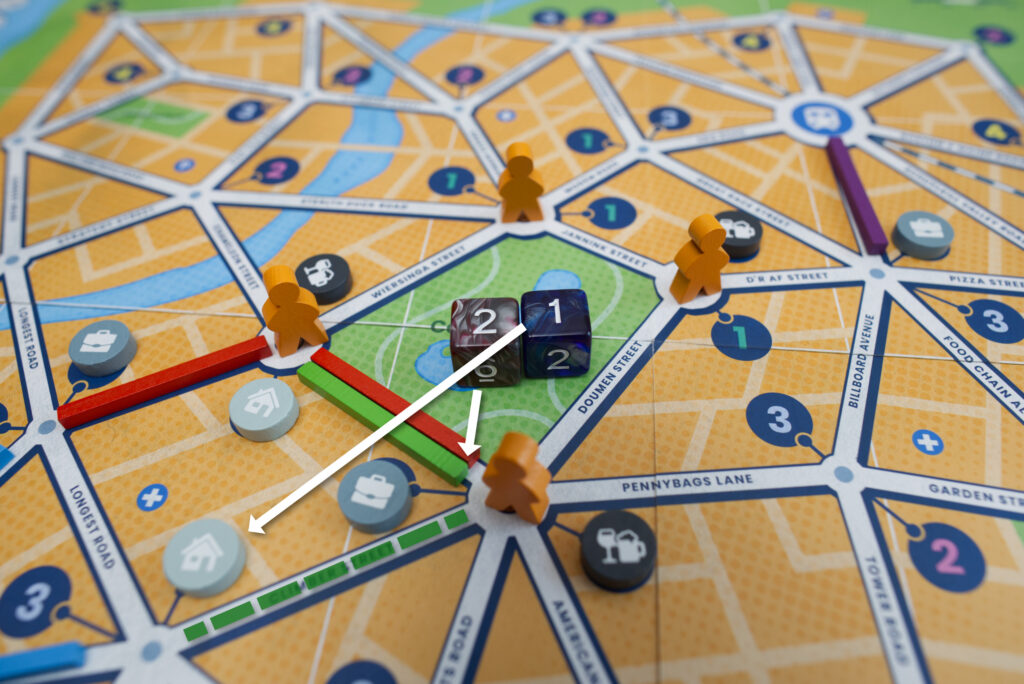
Conclusion
When I played Bus for the first time in mid 2024, it wasn’t because the theme had drawn me in. It also for sure weren’t the components or amazing production. And with a retail price of 80-100€, I wouldn’t have picked it up on a whim. As with pretty much all the other Splotter games I’ve played, I had watched playthroughs and read reviews, but non were able to convey the magic that’s happening when actually playing them.
Instead, I was at a board game café that by chance had a copy and I had already learned – first with Horseless Carriage, then Antiquity and Indonesia – that Splotter makes some of the most innovative, interesting, and out there games there are. It was like being in a book store and picking up that strange looking novel not because but despite the cover and title because you like what the author had done before. I mean the new re-issue looks much cleaner and modern than the original Splotter edition, but still nowhere near what players have come to expect nowadays at this price point.
Upon first play of Bus, it to be honest left me a bit cold. I was intrigued design-wise and how it manages to achieve a lot with rather few rules. It feels similar to Concordia in that you unfold the rules and think “That’s it? Am I missing a couple of pages?”. It is even more impressive considering this game is already 25 years old! But did I have fun? Well, not really. I had a good time, but it didn’t have the same irresistible fascination upon first play I had with the other three games I mentioned. I checked it off as another Splotter game I had finally been able to play, but not something I would necessarily seek out again. I ended up with a copy anyway and now that I have played Bus more, I’m really happy I did! And here is why:
I recently introduced Bus to colleagues of mine, all of which like playing board games but don’t have huge collections or game that frequently. Let me tell you, I can’t remember the last time I heard so much shouting and laughing almost right from the get go! Since the actions are so straight forward, the teach was over fairly quickly followed by the natural disorientation of playing a new game: What the heck are we supposed to do here? What’s a good move?
We started playing and came to the point where someone used the Buildings action for the first time. It took me no more than pointing out that instead of placing a building somewhere as preparation for their next round, the player could also use it to lock in a passenger on an opponent’s bus route to hurt them in this round! All hell broke loose and we were off to the races 😀 Stopping time, cutting off routes, manipulating player order, stealing passengers, … it was like giving a couple of kids an infinite supply of inflatable balloons and a garden hose and off hand mentioning the concept of water bombs. Yes, you’re trying to set up your own route for scoring points. Yes, you are trying maximise what you get out of every single one of your action markers. But it’s at least as much fun (and often as valuable) if you manage to prevent someone else from doing so.
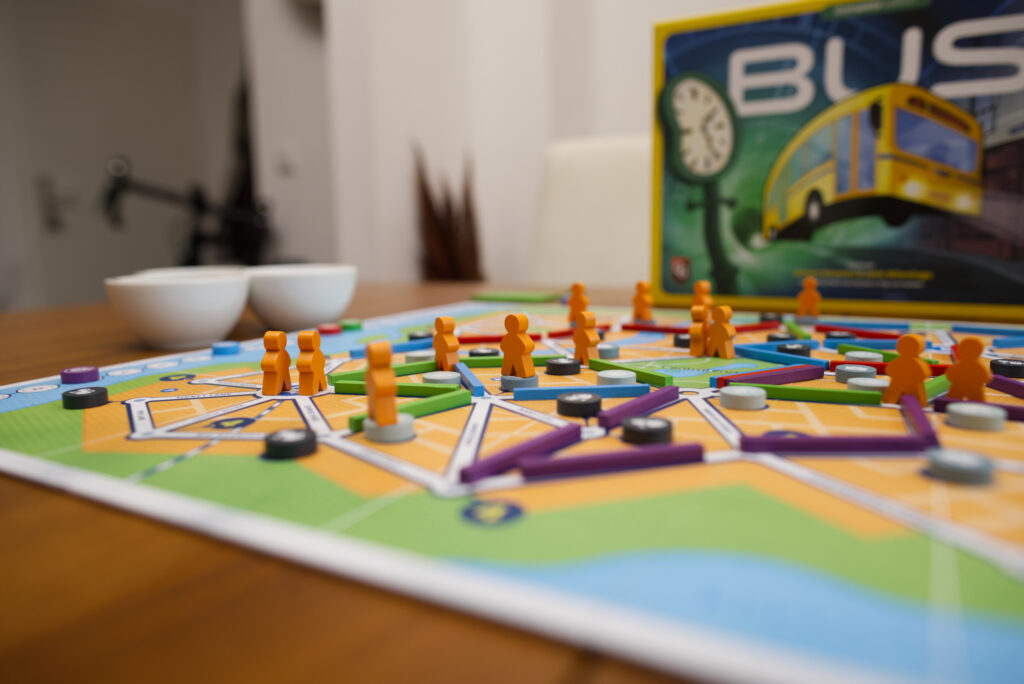
Bus is a refreshing contrast to the multi-player solitaire and point-salady Euros that have become so predominant in recent years. It’s all pure interaction and no randomness. It’s minimal components but maximum results. It’s depth without many rules. It’s a brilliant piece of board game design and a lot of fun even for those players that usually don’t like throwing wrenches into other players’ gears. The nice thing about Bus is how reduced to its essence and straight forward it is.
I wouldn’t put Bus on the same pedestal as Antiquity, Indonesia, and Horseless Carriage (or the fan favourite Food Chain Magnate, which wasn’t quite for me). All of these immediately left me wanting for more and every time I play them I’m discovering something new. They are more evocative where Bus is rather abstract. They are larger in scope where Bus feels more like a confined shared space. But they are also games one needs the right people to play with where Bus is easy to teach and just plain chaotic fun. It’s the game you pull off the shelf when you’re in the mood to open up a beer, really mess with your friends and being messed with yourself. It might be expansive, but it is a great example of why more games should again be less of a math optimisation puzzle and instead something we play foremost with and against the other players. And it is a game that in another 25 years will still feel as fresh and singular as it does now.
